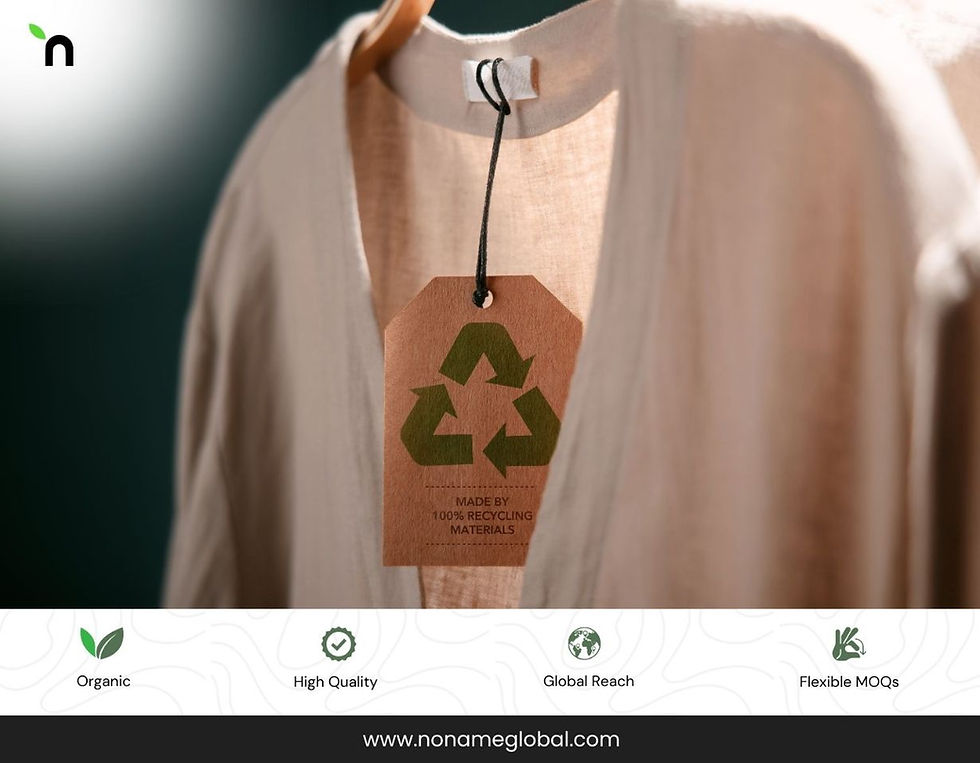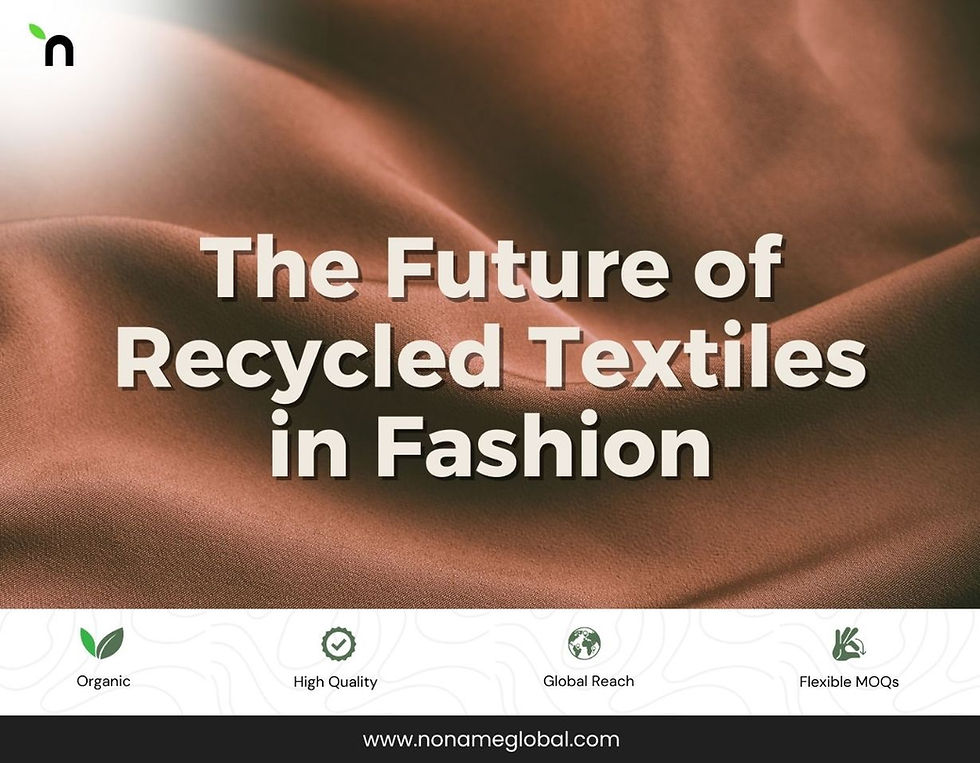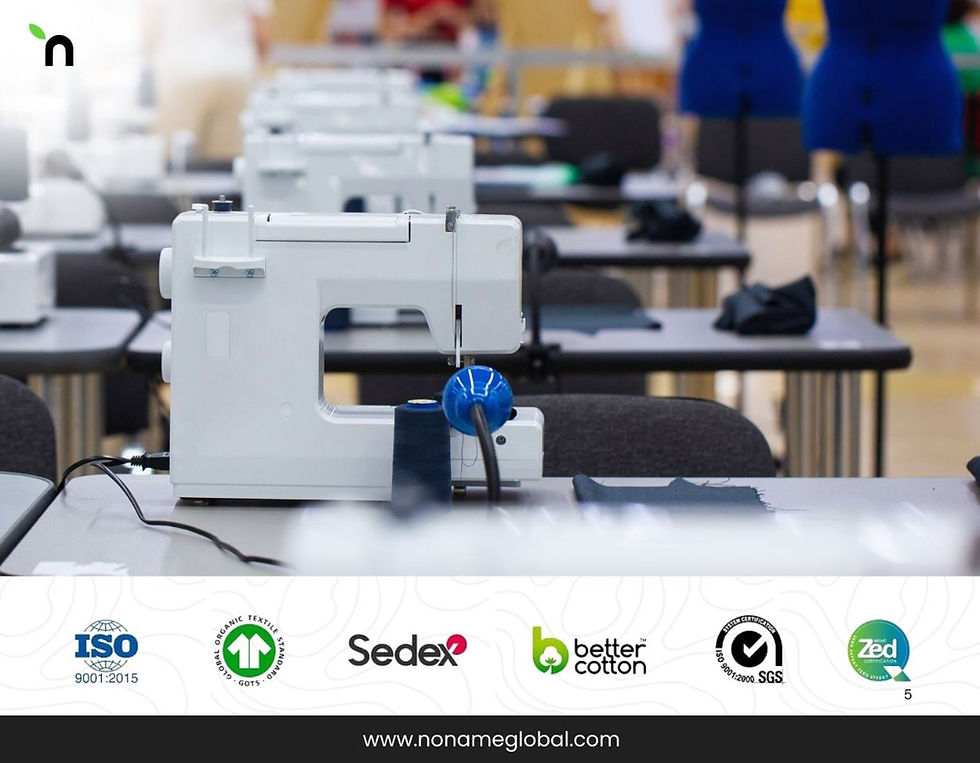Why Top Brands Love Recycled Textiles
- Shraddha Srivastava
- Feb 27, 2025
- 7 min read
Updated: Jul 31, 2025
Summary:
Recycled textiles for clothes manufacturing are changing fashion for good. With eco-friendly materials made from old clothes, factory scraps, and plastic bottles, brands can cut waste, save water, and meet growing demand for sustainability. India, especially Panipat, is leading this green shift—and manufacturers like NoName make it easy for fashion brands to join the movement.
Introduction:
Sustainability is no longer a buzzword—it’s the future of fashion. As global demand for eco-friendly clothing rises, India is leading in sustainable fashion manufacturing. India is setting an example with strong government initiatives, conscious consumer choices, and advanced recycling technology.

At the center of this revolution is Panipat, the "Recycling Capital of India", where millions of tons of discarded fabrics are transformed into high-quality, recycled textiles. From repurposed cotton and polyester to woolen blankets made from recycled fibers, Panipat is proving that waste can be turned into something valuable.
Why does this matter? Because the fashion industry generates a staggering 92 million tons of textile waste annually, and India is playing a crucial role in reducing this number. Here’s how:
Panipat recycles over 100,000 metric tons of textile waste annually, turning discarded clothes into new fabrics.
Recycled polyester (rPET) cuts energy use by up to 75%, significantly reducing carbon emissions.
Recycled cotton saves thousands of liters of water per garment, making it a game-changer in sustainable fashion.
67% of global fashion consumers prioritize sustainable fashion, pushing brands to rethink their approach.
From luxury labels to fast fashion, brands are embracing recycled textiles for clothes manufacturing to reduce waste, lower costs, and meet eco-conscious demand. In this blog, we’ll uncover how recycled textiles are made, why they matter, and the success stories of brands thriving with sustainability.
Plus, we’ll introduce NoName, a leading clothing manufacturer in India, helping fashion brands create high-quality, sustainable garments.
Ready to explore the future of fashion? Let’s dive in!
What Are Recycled Textiles?
Recycled textiles are fabrics made from repurposed materials, such as discarded clothes, factory waste, and even plastic bottles. Instead of producing textiles from resources like cotton, polyester, or wool—which require vast amounts of water, energy, and chemicals—manufacturers transform waste materials into new fabrics.

Types of Recycled Textiles
There are two primary categories of recycled textiles:
1. Post-Consumer Recycled Textiles
These materials come from used clothes, linens, and household fabrics that would otherwise end up in landfills. Consumers donate or recycle their old garments, which are then processed and re-spun into new fibers.
2. Pre-Consumer Recycled Textiles
These include factory offcuts, production scraps, and defective fabrics that are repurposed instead of being discarded. Many manufacturers use these excess materials to create new garments, reducing overall waste.
How Are Recycled Textiles Made?
Turning old clothes, textile waste, and plastic into high-quality fabrics requires advanced technology and a meticulous multi-step process. The journey of recycled textiles involves several stages, from collecting waste materials to transforming them into new garments ready for the market.
Let’s break down the process:
Step 1: Collection & Sorting
The first step in recycled textiles for clothes manufacturing is gathering discarded fabrics, post-consumer garments, and industrial textile waste. This raw material comes from various sources:
Used Clothes – Collected from donation programs, thrift stores, and take-back schemes run by brands.
Factory Waste – Scraps, defective pieces, and overproduction waste from garment manufacturing units.
Plastic Waste – Plastic bottles and other synthetic waste are collected from oceans, landfills, and recycling centers.
Once collected, materials undergo a thorough sorting process:
Fabric Type Sorting – Cotton, polyester, wool, and other textiles are separated since different fibers require different recycling techniques.
Color Sorting – Clothes are grouped by color to reduce the need for chemical dyes later in the process.
Quality Check – Heavily damaged fabrics unsuitable for recycling are removed or repurposed for insulation and industrial applications.
This sorting phase is crucial, as it determines which recycling method (mechanical or chemical) will be used.
Step 2: Fiber Recovery & Processing
Once sorted, the materials are processed to recover fibers and transform them into usable yarns. There are two primary methods:
A. Mechanical Recycling (For Natural Fibers: Cotton, Wool, Linen, etc.)
The sorted fabrics are shredded into small pieces.
These pieces are then pulled apart into raw fibers using specialized machinery.
The recovered fibers are re-spun into new yarns, which are used for fabric production.
Pros: Low energy consumption, no chemicals needed.
Cons: The fibers become shorter and weaker, often requiring blending with virgin fibers for durability.
B. Chemical Recycling (For Synthetic Fibers: Polyester, Nylon, etc.)
Synthetic materials, especially PET polyester from plastic bottles, are broken down at a molecular level using chemical solvents.
The extracted raw materials are purified and re-polymerized into new synthetic fibers.
These fibers can then be used to produce high-performance recycled polyester and nylon fabrics.
Pros: Produces high-quality fibers that can be recycled multiple times.
Cons: Requires more energy and specialized facilities.
Innovations in Recycling:
Some manufacturers are now using bio-based and enzyme-assisted recycling to improve efficiency and minimize environmental impact. These new techniques help preserve fiber strength while eliminating the need for harsh chemicals.
Step 3: Fabric Production & Garment Manufacturing
Once the fibers are recovered, they are transformed into high-quality textiles using eco-friendly production methods. This stage involves:
Spinning the fibers into yarns – Whether mechanically or chemically recycled, fibers are spun into threads that can be woven or knitted.
Weaving or knitting the fabric – The threads are processed into textiles of different textures and strengths, depending on their intended use.
Eco-friendly dyeing & finishing – Instead of traditional chemical dyes, many manufacturers use low-impact dyes or waterless dyeing techniques to reduce pollution.
Garment Manufacturing – The final step is cutting and sewing the fabrics into new clothing, accessories, or other textile products.
By reusing waste materials and reducing dependence on virgin resources, this process ensures that recycled textiles for clothes manufacturing contribute to a circular economy while maintaining quality, comfort, and durability.

Why Should Fashion Retailers Care About Recycled Textiles?
1. Consumer Demand for Sustainability
Today’s shoppers—especially Millennials and Gen Z—are willing to pay more for sustainable products. According to industry reports, over 60% of global consumers prefer brands that use eco-friendly materials.
2. Cost Savings in the Long Run
While the initial investment in recycled textiles for clothes manufacturing may seem high, it leads to cost savings in material sourcing, production efficiency, and waste management.
3. Competitive Advantage in the Fashion Industry
Big brands like Patagonia, Adidas, and Stella McCartney have already built strong reputations by adopting sustainable materials. Small and mid-sized retailers that embrace recycled textiles now can position themselves ahead of the curve.
4. Compliance with Global Regulations
Many governments worldwide are introducing textile recycling laws and imposing higher taxes on unsustainable practices. Brands that integrate recycled textiles into their collections are better prepared for future regulations.
Success Stories: Indian Fashion Brands Leading with Recycled Textiles
Raymond
Raymond, one of India’s biggest textile and apparel brands, has integrated recycled textiles for clothes manufacturing through its Ecovera collection. The collection uses recycled polyester made from post-consumer PET bottles, reducing waste while maintaining premium fabric quality.
Aditya Birla Fashion & Retail (ABFRL)
ABFRL, the powerhouse behind brands like Pantaloons, Van Heusen, and Louis Philippe, has embraced sustainability with its Livaeco fabric, made from recycled and responsibly sourced materials. Their focus on circular fashion is setting a new benchmark for sustainable clothing in India.
Fabindia
Fabindia, known for its handcrafted and organic fabrics, has introduced sustainable and recycled textiles into its collections. By repurposing fabric waste into stylish garments, Fabindia promotes ethical and eco-friendly fashion without compromising on tradition.
HRX by Hrithik Roshan
HRX, one of India’s leading activewear brands, has introduced sustainable sportswear made from recycled polyester. By using plastic waste to create performance-driven apparel, HRX is merging fitness and sustainability.
W for Woman
W for Woman, a popular Indian ethnic wear brand, has incorporated recycled cotton and polyester fabrics into its collections, promoting eco-conscious fashion choices while maintaining its signature fusion wear aesthetic.
These Indian brands are proving that sustainability and style can go hand in hand, making recycled textiles for clothes manufacturing a key part of India’s growing sustainable fashion industry.

The Future of Recycled Textiles in Fashion
As sustainability continues to drive fashion trends, the demand for recycled textiles will only grow. Innovations like bio-based recycling, digital fabric sorting, and advanced fiber regeneration are making recycled textiles for clothes manufacturing more efficient and scalable.
How Can Retailers Adapt?
Prioritize recycled textiles in your next collection to appeal to eco-conscious consumers.
Educate customers about the benefits of buying sustainable fashion.
Partner with sustainable clothing manufacturers like NoName to integrate recycled textiles seamlessly.
A Clothing Manufacturer in India Supporting Sustainable Fashion and Recycled Textiles
At NoName, a leading clothing manufacturer in India, sustainability isn’t just a trend—it’s a commitment. As a sustainable clothing manufacturer in India, NoName actively incorporates recycled textiles into its production processes to help brands create eco-friendly collections.

How NoName Uses Recycled Textiles:
Sourcing premium-quality recycled fabrics that ensure durability and style. Implementing advanced production techniques to reduce carbon footprint. Offering flexible, small-order manufacturing for brands looking to test sustainable collections.
By choosing NoName as a manufacturing partner, fashion brands can easily integrate recycled textiles for clothes manufacturing while maintaining high quality and affordability.
Conclusion
The era of throwaway fashion is fading, and recycled textiles are taking center stage. As more brands commit to sustainability, integrating recycled textiles for clothes manufacturing is no longer optional—it’s essential for long-term success.
For fashion retailers, this is the perfect time to make the shift. Whether you run an independent label or a large fashion house, incorporating recycled textiles will not only reduce your environmental footprint but also boost brand value, attract eco-conscious customers, and enhance profitability.
As a clothing manufacturer in India, NoName is here to help brands transition to sustainable production with high-quality recycled textiles.
The question is: Are you ready to make the change?
WhatsApp: +91-9717 508 508
Email: hello@nonameglobal.com
Website: www.nonameglobal.com
Online meeting: https://calendly.com/nonameglobal/meet














Comments